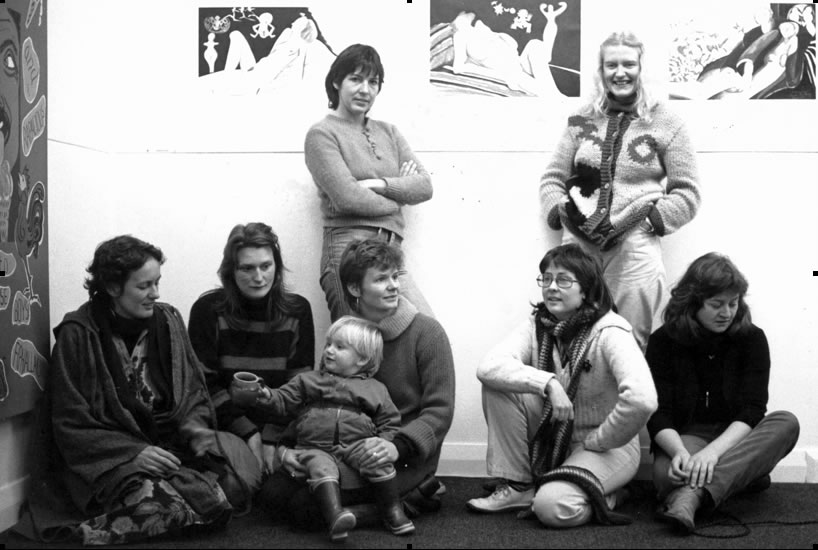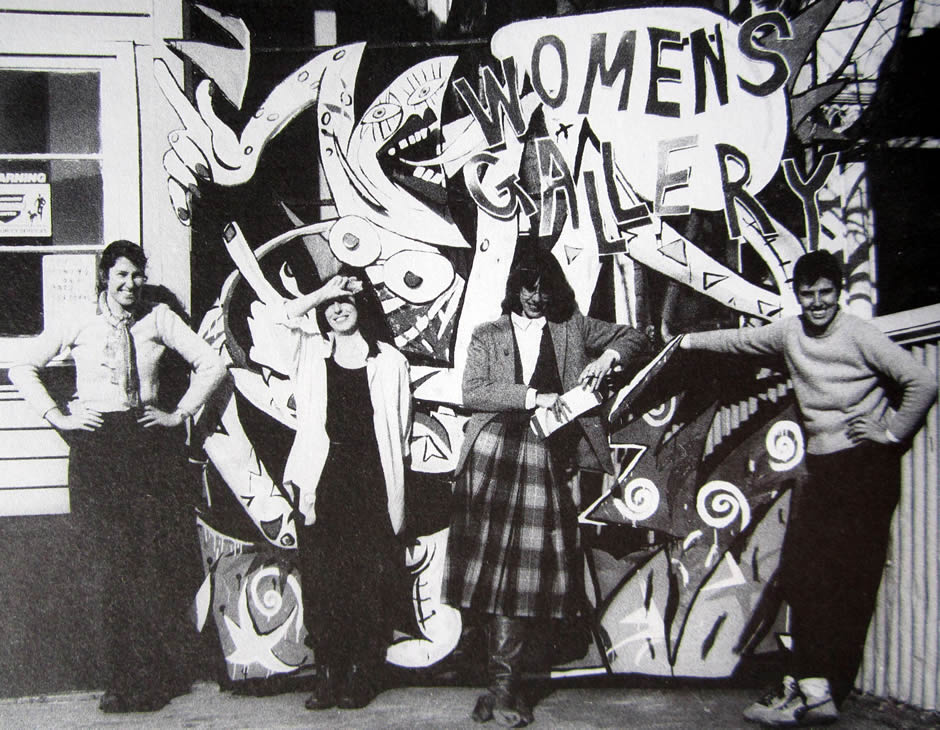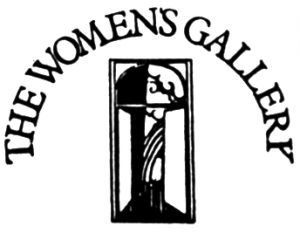This essay written by Marian Evans was first published in Women Together: a History of Women's Organisations in New Zealand in 1993. It was updated by Marian Evans in 2019.
The women's art movement of the 1970s reached Wellington through Joanna Margaret Paul, who organised the project 'A season's diaries' in 1977. Paul invited six women living in Christchurch and Wellington – four of whom identified as artists – to join her in keeping a visual diary for a month. These diaries were then exhibited in the Victoria University Library and later elsewhere.
After an unsuccessful attempt to organise a travelling exhibition of Paul's and Allie Eagle's work, three of the contributors decided to establish a women's gallery in Wellington, to be concerned (as 'A season's diaries' was) with women's everyday realities and the expression of these in an art form. They intended to transform the meaning and function of a public gallery and to work at a national level, hoping to bring together women who were working in isolation and wanted a women's context, whether or not they were consciously feminist. They also wanted to welcome as valued contributors women who did not see themselves as artists.

Queen Elizabeth II Arts Council.
Women’s Gallery collective, 26 Harris Street, 1981. Back, l-r: Sharon Alston, Louise Genet; front, l-r: Marian Evans, Bridie Lonie, Isaac Leniston, Marg Leniston, Hilary King, Anna Keir.
The Women's Gallery opened in January 1980 below Photoforum at 26 Harris Street, with a show by artists from around the country and an associated programme which involved many local women. During the four years that followed, theme exhibitions and group shows, poetry and story readings, performances, music evenings, parties, film and video showings, school holiday programmes, skills workshops, seminars and regular special interest group meetings provided ongoing interest and opportunities for participation.
The theme shows were particularly successful; they included 'Self Image', 'Māori Women's Art' (both traditional and contemporary), 'Mothers' (which toured nationally and to Sydney), 'Women and Violence', 'Sexxuality' [sic], 'Women and the Environment', 'Diaries', 'Political Posters' (which toured), 'Fabrics', 'Spirituality', and 'Children and Childhood'. Most of these had associated programmes; for example, a Women and Justice seminar, held as part of 'Women and Violence':
packed out the little theatrette in the Wellington Library with women that none of us had ever seen before – meaning we are reaching all kinds of women – who stayed all day and talked and talked and argued and argued and argued, and when the doors were closed they stood around outside and kept on . . . [1]
In 1982 the gallery moved to the ground floor of 323 Willis Street, a building occupied only by women. An artist lived and a therapist worked on the upper floor for a time, and the New Mothers Support Group operated from the gallery.

Marian Evans
Women’s Gallery collective, in front of Debra Bustin sign, 323 Willis St, 1982. L-r: Celia Elizabeth, Linda Pearl, Linda Hardy, Barb McDonald.
The publishing groups Kidsarus 2 and Spiral were closely connected with the gallery throughout. Because it was so visible, it was used as a source of information about other women's organisations and resources, such as the Hecate Women's Health Collective, Women's Resource Centre, Women's Refuge and Women's Place Bookshop. Exhibitions – except for a lesbian one – were open to all members of the public, but associated programmes were open only to women. Some women found this policy reassuring, seeing it as 'non-separatist'.
The gallery was run as a collective by women who worked there, whether paid (usually through Labour Department schemes) or as volunteers. There was constant tension among them because of lack of money, the ambitious programme, and the expectations of visitors and participants. Artist workers sometimes found it frustrating to be unable to do their own work while having to work very hard for other artists. There were conflicts about priorities and, as more work was sold, over whether to develop into a more sophisticated dealer gallery for women artists. Eventually, a series of burglaries, flagging energy, and the rejection of an application to the Department of Internal Affairs for ongoing funding led to the gallery's closure in 1984.
In the early 1990s the Women's Gallery Incorporated, a charity, and its networks were still being activated intermittently for projects which confronted discrimination against women artists or writers and enabled their work to reach a wider public.
Marian Evans
1993 – 2005
The Women’s Gallery Incorporated lasted from 20 May 1980 to 14 October 2005. [2] For much of that time it was an umbrella organisation with charitable status, and a fiscal sponsor for Spiral projects. Over a decade later, Kirsty Baker’s thesis Inhabiting the Threshold, with its careful reassessment of elements of the organisation’s curatorial practices, provided finality for some former collective members. [3]
Marian Evans
Notes
[1] Pauline Neale to Maxine Schur, 28 November 1980, Spiral, The Women's Gallery, Kidsarus and Kidsarus 2 collections, 1975–, ATL.
[2] Incorporated Society No. 218575.
[3] Baker, 2016.
Unpublished sources
Baker, Kirsty, ‘Inhabiting the Threshold: The Women’s Gallery as Liminal Space in New Zealand’s Feminist Art History’, MA (Art History) thesis, Victoria University of Wellington 2016. Available from: http://researcharchive.vuw.ac.nz/handle/10063/5129
Spiral, The Women's Gallery, Kidsarus and Kidsarus 2 collections, 1975– (including The Women's Gallery newsletter, 1983–84), ATL
Published sources
Auckland Women's Community Video and Women's Gallery, Interview, Anna Keir, Marian Evans, Nancy Peterson, 26 Harris Street, Wellington (video, 20 mins), 1980, https://www.youtube.com/watch?v=-UZOLx83ADk
Evans, Marian, ‘Why a Women’s Gallery?’, in The Women’s Gallery, catalogue for opening show, Jan. 1980, posted on Spiral Collectives, 9 June 2016, https://medium.com/spiral-collectives/why-a-womens-gallery-bdf3121a70fe
Evans, Marian, Bridie Lonie, and Tilly Lloyd (eds), A Women's Picture Book: 25 Women Artists of Aotearoa (New Zealand), GP Books, Wellington, 1988
Evans, Marian, ‘We Are Unsuitable For Framing’, n.paradoxa: Material Histories, Vol. 24, 2009, 49–58
Evans, Marian, ‘They Might Have Completely Forgotten Us’, Wellywood Woman, 2013, reposted on Spiral Collectives, 9 Feb. 2016, https://medium.com/spiral-collectives/they-might-have-completely-forgotten-us-26b55cd68e69
Evans, Marian, ‘Kirsty Baker’s “Inhabiting the Threshold” [interview], Spiral Collectives, 26 Oct. 2016, https://medium.com/spiral-collectives/kirsty-bakers-inhabiting-the-threshold-5d13c103212c
Lonie, Bridie, ‘Diary of a Season: A Proposal for a Women’s Exhibition’, Landfall, No. 125, March 1978, 63–66, updated and posted with permission on Spiral Collectives, 6 June 2016, https://medium.com/spiral-collectives/diary-of-a-season-a-proposal-for-a-womens-exhibition-fab0d373a3a0
Lonie, Bridie, ‘The Women’s Gallery and Maeve’, Spiral 5, 1982, posted on Spiral Collectives, 6 June 2016, https://medium.com/spiral-collectives/the-womens-gallery-maeve-6ecc9f63d855
Lonie, Bridie and Susan Ballard, ‘Telling Minor Histories and Writing Theory Practices: A Conversation on Feminist Pedagogy from New Zealand’, n.paradoxa: Feminist Pedagogies, Vol. 26, 2010, 30–37
Spiral Collectives: An Open Research Project, 2016 onwards, https://medium.com/spiral-collectives
The Women's Gallery, Mothers [exhibition catalogue], Wellington, 1981


Community contributions